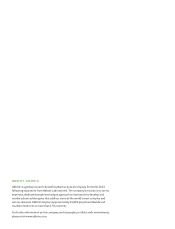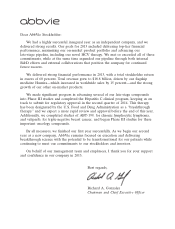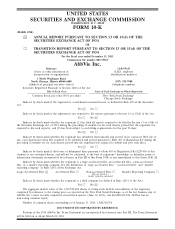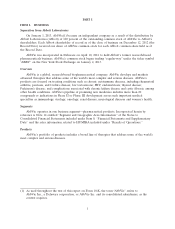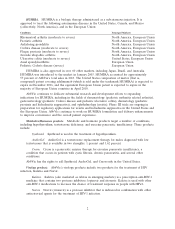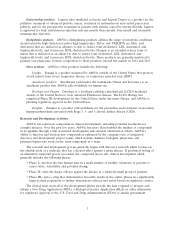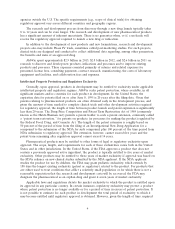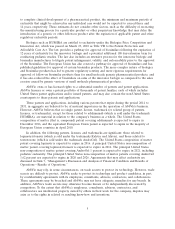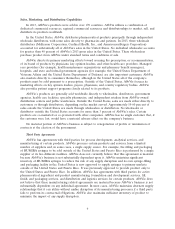AbbVie 2013 Annual Report Download - page 8
Download and view the complete annual report
Please find page 8 of the 2013 AbbVie annual report below. You can navigate through the pages in the report by either clicking on the pages listed below, or by using the keyword search tool below to find specific information within the annual report.agencies outside the U.S. The specific requirements (e.g., scope of clinical trials) for obtaining
regulatory approval vary across different countries and geographic regions.
The research and development process from discovery through a new drug launch typically takes
8 to 12 years and can be even longer. The research and development of new pharmaceutical products
has a significant amount of inherent uncertainty. There is no guarantee when, or if, a molecule will
receive the regulatory approval required to launch a new drug or indication.
In addition to the development of new products and new formulations, research and development
projects also may include Phase IV trials, sometimes called post-marketing studies. For such projects,
clinical trials are designed and conducted to collect additional data regarding, among other parameters,
the benefits and risks of an approved drug.
AbbVie spent approximately $2.9 billion in 2013, $2.8 billion in 2012, and $2.6 billion in 2011 on
research to discover and develop new products, indications and processes and to improve existing
products and processes. These expenses consisted primarily of salaries and related expenses for
personnel, license fees, consulting payments, contract research, manufacturing, the costs of laboratory
equipment and facilities, and collaboration fees and expenses.
Intellectual Property Protection and Regulatory Exclusivity
Generally, upon approval, products in development may be entitled to exclusivity under applicable
intellectual property and regulatory regimes. AbbVie seeks patent protection, where available, in all
significant markets and/or countries for each product in development. In the United States, the
expiration date for patents filed on or after June 8, 1995 is 20 years after the filing date. Given that
patents relating to pharmaceutical products are often obtained early in the development process, and
given the amount of time needed to complete clinical trials and other development activities required
for regulatory approval, the length of time between product launch and patent expiration is significantly
less than 20 years. The Drug Price Competition and Patent Term Restoration Act of 1984 (commonly
known as the Hatch-Waxman Act) permits a patent holder to seek a patent extension, commonly called
a ‘‘patent term restoration,’’ for patents on products (or processes for making the product) regulated by
the Federal Food, Drug, and Cosmetic Act. The length of the patent extension is roughly based on
50 percent of the period of time from the filing of an Investigational New Drug Application for a
compound to the submission of the NDA for such compound, plus 100 percent of the time period from
NDA submission to regulatory approval. The extension, however, cannot exceed five years and the
patent term remaining after regulatory approval cannot exceed 14 years.
Pharmaceutical products may be entitled to other forms of legal or regulatory exclusivity upon
approval. The scope, length, and requirements for each of these exclusivities varies both in the United
States and in other jurisdictions. In the United States, if the FDA approves a product that does not
contain a previously approved active ingredient, the product is typically entitled to five years of market
exclusivity. Other products may be entitled to three years of market exclusivity if approval was based on
the FDA’s reliance on new clinical studies submitted by the NDA applicant. If the NDA applicant
studies the product for use by children, the FDA may grant pediatric exclusivity, which extends by
180 days the longest existing exclusivity (patent or regulatory) related to the product. For products that
are either used to treat conditions that afflict a relatively small population or for which there is not a
reasonable expectation that the research and development costs will be recovered, the FDA may
designate the pharmaceutical as an orphan drug and grant it seven years of market exclusivity.
Applicable laws and regulations dictate the market exclusivity to which the product is entitled upon
its approval in any particular country. In certain instances, regulatory exclusivity may protect a product
where patent protection is no longer available or for a period of time in excess of patent protection. It
is not possible to estimate for each product in development the total period of exclusivity to which it
may become entitled until regulatory approval is obtained. However, given the length of time required
4


